Riverdi, a TouchGFX Expert, is celebrating the availability of the STM32C071 with the release of a new Display Kit featuring the microcontroller. Popular for its STM32 Embedded Displays, the ST Authorized Partner usually offers complete development boards with a display attached. Ranging from 1.54-inch to 12.1-inch, their solutions include STM32H7s and STM32U5s. The new Nucleo-64 display kit, which only comes with the display, is thus an original approach for the maker that wants to target cost-effective proofs-of-concept and engineers looking to rapidly add a graphical user interface while keeping BOM costs low. And thanks to its close partnership with ST, Riverdi displays are available within TouchGFX Designer, so developers can use them immediately.
What’s new?
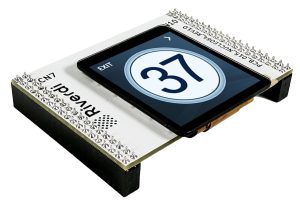
The latest STM32 Nucleo 64 Display Kit will work with the newly released STM32C071. It is also compatible with entry-level STM32 boards, such as the NUCLEO-G071RB, NUCLEO-WB55RG, NUCLEO-U083RC, and NUCLEO-H503RB, which are all supported in TouchGFX Designer.
The STM32 Nucleo 64 Display Kit features a 1.54-inch IPS display with a resolution of 240 x 240 and a brightness of 500 nits that still manages a relatively low power consumption. It also includes a touch panel using an I2C interface to enable a more intuitive UI, and it comes with 8 MB of flash memory to help store certain assets. In most cases, developers will start by attaching this new Display Kit on one of the compatible boards and run the demo code available in TouchGFX Designer. It’s often the best way to start a proof-of-concept and get a feel for future implementations.
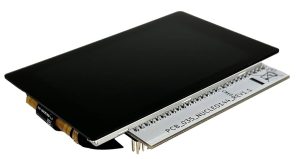
Riverdi also released an STM32 Nucleo 144 Display Kit. Compatible with the NUCLEO-H563ZI and NUCLEO-U575ZI-Q, the kit features a 3.5-inch display with a resolution of 320 x 480 and a PCAP touch panel relying on an I2C interface. It also comes with 8 MB of flash, but this particular Display Kit uses Quad SPI protocol. As the screen is bigger and brighter (1,200 nits), Riverdi knows that developers will want to run high-quality interfaces with more complex graphics. The faster memory interface ensures that users can feed the larger frame buffer without a bottleneck.
Why Do Displays Still Challenge Embedded Systems?
Sourcing issues at low volumes
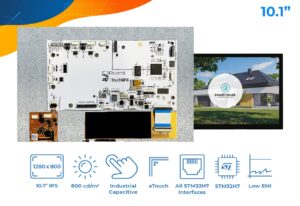
Sourcing a display remains one of an embedded system’s most expensive and complex aspects of a project, especially at low volumes. Indeed, makers don’t know how to fulfill orders for only 1,000 or 10,000 units or can’t guarantee them for extended periods. As a result, smaller companies must either take huge risks by ordering large quantities or risk having a part discontinued, forcing them to redesign their system. However, graphical user interfaces are increasingly popular and more accessible than ever. Frameworks like TouchGFX vastly simplify development operations, which lowers the barrier to entry. The challenge is to work with display makers whose manufacturing processes hugely favor high volumes of orders.
Creating an ecosystem with answers
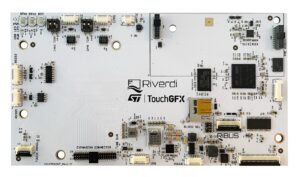
It’s precisely to answer this challenge that ST came up with the X-NUCLEO-GFX01M2 and X-NUCLEO-GFX02Z1. The two display boards aim to help companies find components that keep their bill of materials down and can help with prototyping. However, what if a team needs a bigger display or larger volume incompatible with X-NUCLEo boards. Riverdi fills the gap by offering an HD screen on a development tool that is ready out of the box. It also explains why ST and Riverdi worked together to ensure the STM32 Embedded Displays are available within TouchGFX Designer. Developers can run demos in a few clicks and even use the other ST tools, such as STM32CubeMX and STM32CubeIDE.
How do STM32 Embedded Displays solve this challenge?
Making HD displays ubiquitous
Let’s take the example of an STM32 Embedded Display from Riverdi incorporating a dual-core STM32H747XIH6 with 2 MB of flash and 1 MB of RAM. The board also includes up to 64 MB of external QSPI flash and 8 MB of external SDRAM for graphical assets and frame buffers. Moreover, the system has a micro-SD card slot for greater expansion storage. Riverdi chose this MCU because its dual-core architecture meant it could drive two displays. Hence, the company added a RiBUS port to simplify the conception of an embedded system with multiple screens, something extremely rare in this industry. Finally, Riverdi worked on shielding its solution from electromagnetic interferences to help customers meet their regional certifications.
Helping engineers tailor their design
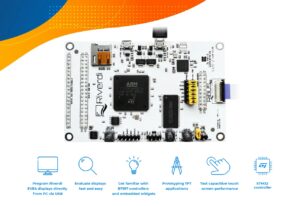
Engineers can tailor their STM32 Embedded Displays by choosing whether to use a touch panel, optical or air bonding, the shape of the touch detection, and whether to add a frame. It should, therefore, help teams price their system according to their needs. The company also offers an STM32 evaluation board with no display. The PCB comes with a Riverdi EVE4 module that supports the company’s displays from 3.5-inch to 10.1-inch. Hence, designers looking for smaller screens can still bypass the market’s challenges to source components in lower volume.




